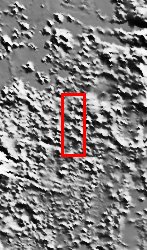Cerberus
Caption:

(Released 24 April 2002)
The Science
The Cerberus feature is a relatively dark region at the southeastern edge of the huge Elysium Mons volcanic complex. It was visible to early astronomers of Mars because it was a distinctive dark spot on a large bright region of the planet. Today we recognize that the Cerberus region encompasses a range of geologic terrains from relatively young and smooth lava flows to the very rugged, ancient eroded landscape seen in this THEMIS image. The Cerberus feature has also proven to be ephemeral. Compared to just 20 years ago when the Viking orbiter instruments viewed the planet, the Cerberus feature has shrunk down from its original length of roughly 1000 kilometers to just a few isolated dark splotches of just a few 100 kilometers. This is testament to the active eolian environment on Mars where global dust storms can lift and then later deposit significant amounts of dust, brightening formerly dark surfaces. The THEMIS image occurs in a portion of Cerberus that remains relatively dark and dust-free although in the bottommost portion of the image are faint, criss-crossing lines that likely are dust devil tracks. The abundant dune-like features covering many of the low, smooth surfaces are similar to those found in many places across the planet. They are evidence of the interaction of wind and movable particles at the surface but not necessarily in today's environment. In many other places on Mars they are clearly inactive; relicts of a different climate.
The Story
Hellhound of Greek mythology, Cerberus was the three-headed, dragon-tailed dog that stood guard at the opening to the underworld. This rough-and-tumble Mars terrain looks just as fierce and foreboding. At the edge of the huge Elysium Mons volcano complex, the Cerberus area appeared as a dark spot to early Mars astronomers in an otherwise bright region of the planet. If this dark area seems somewhat hellish to your imagination too, you'll be glad to know that the Martian wind has been brightening up the area.
Just twenty years ago, the Viking orbiters reached Mars for the first long-term studies of Mars up close. The Cerberus feature was then almost 600 miles long, but has now been vanquished down to few small splotches about 60 miles long. Call that a triumph of lightness upon the surface, but don't think that the force bringing back the light is gentle and kind. The Martian wind can kick up a fierce global dust storm that lifts up the bright Martian dust into the air and then blankets the surface with the brighter material as it settles down again.
The ancient, eroded terrain in this image is still rather dark and dust free, so you might say it's one area where a mythical Cerberus still guards its shrinking territory. The wind teases it, however, by kicking up small, whirling dust devils that leave long, dark, scratchy tracks upon the land. Fields of dunes wrinkle the surface in places as well, but they may be permanently cemented upon the surface now, no longer able to blow and drift as they did in their younger days.
Cataloging Keywords:
| Name |
Value |
Additional Values |
| Target |
Mars |
|
| System |
|
|
| Target Type |
Planet |
|
| Mission |
2001 Mars Odyssey |
Viking |
| Instrument Host |
Mars Odyssey |
|
| Host Type |
Orbiter |
|
| Instrument |
Thermal Emission Imaging System (THEMIS) |
|
| Detector |
|
|
| Extra Keywords |
Atmosphere, Dune, Dust, Grayscale, Mountain, Rotation, Storm, Volcano |
| Acquisition Date |
|
| Release Date |
2002-05-21 |
| Date in Caption |
2002-04-24 |
|
| Image Credit |
NASA/JPL/Arizona State University |
| Source |
photojournal.jpl.nasa.gov/catalog/PIA03776 |
| Identifier |
PIA03776 |


